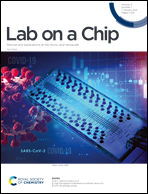A semi-dry chemistry hydrogel-based smart biosensing platform for on-site detection of metal ions†
Abstract
Balancing operability and performance has long been a focus of research in bioanalysis and biosensing. In this work, between the traditional wet chemistry and dry chemistry, we develop a semi-dry smart biosensing platform with favourable operability and performance for metal ions detection. This platform is based on the integration of a stimuli-responsive hydrogel with intelligent image recognition. The hydrogel consists of agarose as a matrix and well-designed fluorescent DNA probes as response elements. Target metal ions in a test sample can diffuse into the hydrogel and activate the DNA probes, outputting fluorescence signals for intelligent imaging. In this way, sensitive and convenient detection of metal ions such as potassium ions (K+) and mercury ions (Hg2+) can be achieved without the assistance of huge instruments and professional workers. The detection limits for K+ and Hg2+ are 0.34 mM and 5.6 nM, respectively. Detection of ions in serum and lake water is also available. Moreover, the hydrogel-based biosensing platform exhibits favorable selectivity, anti-degradation ability, and long-term stability. High-throughput testing can be also achieved by punching multiple test microwells in a single piece of hydrogel. The concept and successful practice of a semi-dry chemistry-based strategy make up for the shortcomings of wet chemistry and dry chemistry, and provide a promising approach for on-site testing.



 Please wait while we load your content...
Please wait while we load your content...